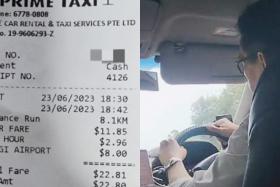The dynamic pricing conundrum
Four taxi companies are expected to roll out a "dynamic pricing" option later this week, a pricing mechanism used by private-hire services Uber and GrabCar.
ComfortDelGro said it will hold off dynamic pricing for the moment and Prime has not given a firm indication of whether it will introduce such a system.
While flat charges are a welcome alternative to the complicated taxi fare structure, they are also less transparent.
As it is now, some cabbies are only appearing after midnight to earn the extra 50 per cent late-night levy.
Ride-hailing apps use algorithms to calculate fares and surge pricing which keep commuters in the dark about the premium they are actually forking out during a period of high demand.
The suggested taxi dynamic pricing system will have cab companies quoting a single flat fare when commuters book their taxis through a new function in the Grab app, called JustGrab.
Now flag-down charges range from $3.20 to $3.90, and there are at least 10 different types of surcharges.
Ride-hailing apps have won over commuters as they are generally cheaper during the off-peak hours. The apps also do not levy a 50 per cent surcharge after midnight.
By adjusting fares in real-time based on the supply of cabs and passenger demand, taxis can possibly be priced more competitively against private-hire cars throughout the day.
But if taxi companies adopt dynamic pricing, will it also allow fare levels to peak and trough unbridled?
Surge pricing adopted by the apps has drawn flak from some commuters, after fares sky-rocketed during periods of exceptionally high demand.
If fares are left up to market forces, it could very well be priced only in favour of those with deeper pockets.
Get The New Paper on your phone with the free TNP app. Download from the Apple App Store or Google Play Store now


